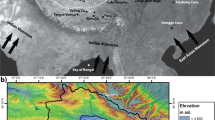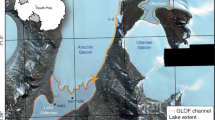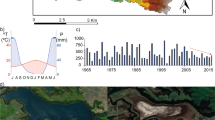Abstract
Anthropogenic aerosol increases over the past few decades have weakened the Asian summer monsoon1,2,3 with potentially far-reaching socio-economic and ecological repercussions. However, it is unknown how these changes will affect freshwater ecosystems that are important to densely populated regions of Asia. High-resolution diatom records and other proxy data archived in lake sediment cores from the Chinese Loess Plateau allow the comparison of summer monsoon intensity, lake trophic status and aquatic ecosystem responses during warming periods over the past two millennia. Here we show that an abrupt shift towards eutrophic limnological conditions coincided with historical warming episodes4,5, marked by increased wind intensity and summer monsoon rainfall leading to phosphorus-laden soil erosion and natural lake fertilization. In contrast, aerosol-affected Anthropocene warming catalysed a marked weakening in summer monsoon intensity leading to decreases in soil erosion and lake mixing. The recent warm period triggered a strikingly different aquatic ecosystem response with a limnological regime shift marked by turnover in diatom species composition now dominated by oligotrophic taxa, consistent with reductions in nutrient fertilization, reduced ice cover and increased thermal stratification6. Anthropogenic aerosols have altered climate–monsoon dynamics that are unparalleled in the past ∼2,000 years, ushering in a new ecological state.
This is a preview of subscription content, access via your institution
Access options
Access Nature and 54 other Nature Portfolio journals
Get Nature+, our best-value online-access subscription
$29.99 / 30 days
cancel any time
Subscribe to this journal
Receive 12 print issues and online access
$209.00 per year
only $17.42 per issue
Buy this article
- Purchase on Springer Link
- Instant access to full article PDF
Prices may be subject to local taxes which are calculated during checkout




Similar content being viewed by others
References
Yu, S. et al. Anthropogenic aerosols are a potential cause for migration of the summer monsoon rain belt in China. Proc. Natl Acad. Sci. USA 113, E2209–E2210 (2016).
Bollasina, M. A., Ming, Y. & Ramaswamy, V. Anthropogenic aerosols and the weakening of the South Asian summer monsoon. Science 334, 502–505 (2011).
Menon, S., Hansen, J., Nazarenko, L. & Luo, Y. Climate effects of black carbon aerosols in China and India. Science 297, 2250–2253 (2002).
Yan, Q., Zhang, Z., Wang, H. & Jiang, D. Simulated warm periods of climate over China during the last two millennia: the Sui–Tang warm period versus the Song–Yuan warm period. J. Geophys. Res. 120, 2229–2241 (2015).
Ge, Q., Zheng, J., Hao, Z. & Liu, H. General characteristics of climate changes during the past 2000 years in China. Sci. China Earth Sci. 56, 321–329 (2013).
Rühland, K. M., Paterson, A. M. & Smol, J. P. Lake diatom responses to warming: reviewing the evidence. J. Paleolimnol. 54, 1–35 (2015).
Liu, T. Loess and the Environment (China Ocean, 1985).
Fu, B. J. Soil erosion and its control in the Loess Plateau of China. Soil Use Manage. 5, 76–82 (1989).
IPCC Climate Change 2013: The Physical Science Basis (eds Stocker, T. F. et al.) (Cambridge Univ. Press, 2013).
Xin, Z., Yu, X., Li, Q. & Lu, X. X. Spatiotemporal variation in rainfall erosivity on the Chinese Loess Plateau during the period 1956–2008. Reg. Environ. Change 11, 149–159 (2011).
Tao, Y., Wei, M., Ongley, E., Li, Z. & Jingsheng, C. Long-term variations and causal factors in nitrogen and phosphorus transport in the Yellow River, China. Estuar. Coast Shelf Sci. 86, 345–351 (2010).
Liu, J. & Diamond, J. China’s environment in a globalizing world. Nature 435, 1179–1186 (2005).
Xu, M. et al. Steady decline of East Asian monsoon winds, 1969–2000: evidence from direct ground measurements of wind speed. J. Geophys. Res. 111, D24111 (2006).
Li, X. Q., Ting, M., Li, C. H. & Henderson, N. Mechanisms of Asian summer monsoon changes in response to anthropogenic forcing in CMIP5 models. J. Clim. 28, 4107–4125 (2015).
Salzmann, M., Weser, H. & Cherian, R. Robust response of Asian summer monsoon to anthropogenic aerosols in CMIP5 models. J. Geophys. Res. 119, 11321–11337 (2014).
Song, F., Zhou, T. & Qian, Y. Responses of East Asian summer monsoon to natural and anthropogenic forcings in the 17 latest CMIP5 models. Geophys. Res. Lett. 41, 596–603 (2014).
Liu, J., Wang, B., Cane, M. A., Yim, S. Y. & Lee, J. Y. Divergent global precipitation changes induced by natural versus anthropogenic forcing. Nature 493, 656–659 (2013).
Smith, D. M. et al. Role of volcanic and anthropogenic aerosols in the recent global surface warming slowdown. Nat. Clim. Change 6, 936–940 (2016).
Lu, C. & Tian, H. Half-century nitrogen deposition increase across China: a gridded time-series data set for regional environmental assessments. Atmos. Environ. 97, 68–74 (2014).
Wang, Q., Fan, X. & Wang, M. Recent warming amplification over high elevation regions across the globe. Clim. Dynam. 43, 87–101 (2014).
Mountain Research Initiative EDW Working Group. Elevation-dependent warming in mountain regions of the world. Nat. Clim. Change 5, 424–430 (2015).
Hall, R. I. & Smol, J. P. The Diatoms: Applications for the Environmental and Earth Sciences (eds Smol, J. P. & Stoermer, E. F.) 122–151 (Cambridge Univ. Press, 2010).
Chen, J. H. et al. Hydroclimatic changes in China and surroundings during the medieval climate anomaly and Little Ice Age: spatial patterns and possible mechanisms. Quat. Sci. Rev. 107, 98–111 (2015).
Zhang, P. Z. et al. A test of climate, sun, and culture relationships from an 1810-year Chinese cave record. Science 322, 940–942 (2008).
Tan, L. et al. Centennial-to decadal-scale monsoon precipitation variability in the semi-humid region, northern China during the last 1860 years: records from stalagmites in Huangye Cave. Holocene 21, 287–296 (2011).
Liu, J., Wang, B., Wang, H., Kuang, X. & Ti, R. Forced response of the East Asian summer rainfall over the past millennium: results from a coupled model simulation. Clim. Dynam. 36, 323–336 (2011).
Yang, J. R., Pick, F. R. & Hamilton, P. B. Changes in the planktonic diatom flora of a large mountain lake in response to fertilization. J. Phycol. 32, 232–243 (1996).
Ge, Q. S. et al. Winter half-year temperature reconstruction for the middle and lower reaches of the Yellow River and Yangtze River, China, during the past 2000 years. Holocene 13, 933–940 (2003).
Bracht, B. B., Stone, J. R. & Fritz, S. C. A diatom record of late Holocene climate variation in the northern range of Yellowstone National Park, USA. Quat. Int. 188, 149–155 (2008).
Yi, S. Holocene Vegetation Responses to East Asian Monsoonal Changes in South Korea (INTECH Open Access Publisher, 2011).
Fu, B. J. et al. Assessing the soil erosion control service of ecosystems change in the Loess Plateau of China. Ecol. Complexity 8, 284–293 (2011).
Liu, J. B. et al. Humid Medieval Warm Period recorded by magnetic characteristics of sediments from Gonghai Lake, Shanxi, North China. Chin. Sci. Bull. 56, 2464–2474 (2011).
Ramsey, C. B. Deposition models for chronological records. Quat. Sci. Rev. 27, 42–60 (2008).
Appleby, P. G. in Tracking Environmental Change using Lake Sediments-Volume 1: Basin Analysis, Coring, and Chronological Techniques (eds Last, W. M. & Smol, J. P.) 171–203 (Springer, 2001).
Battarbee, R. W. et al. in Tracking Environmental Change using Lake Sediments-Volume 3: Terrestrial, Algal, and Siliceous Indicators (eds Smol, J. P., Birks, H. J. B. & Last, W. M.) 155–202 (Springer, 2001).
Acknowledgements
We thank members of the Paleoecological Environmental Assessment and Research Laboratory and G. J. Chen for their help with the laboratory analyses; S. Kandasamy, Z. L. Wang, L. Lin, M. R. Qiang, G. H. Dong, Y. L. Li, X. S. Zhang and Y. Li for critical discussions and reading of the manuscript; X. J. Zhang and Z. P. Zhang for assistance in figure preparation; and Z. L. Wang, X. Y. Cao and Y. C. Li for fieldwork, respectively. This work was supported by the National Natural Science Foundation of China (No. 41601186, 41130102, 41471162 and 41505043), Fundamental Research Funds for the Central Universities (No. lzujbky-2016-155), and the Natural Sciences and Engineering Research Council of Canada to J.P.S.
Author information
Authors and Affiliations
Contributions
J.P.S. and F.C. designed this study. J.P.S., J.L., K.M.R. and F.C. led the interpretation and writing. Q.X. and J.C. organized field work. J.P.S., K.M.R. and J.L. led the diatom analysis. J.L., K.M.R. and J.P.S. performed diatom analysis. J.L. and J.C. performed geochemical data analysis. J.L., K.M.R. and F.C. constructed the age-depth model. J.L., J.P.S., K.M.R., Y.X., J.C., S.C., F.C., Q.C. and H.W. wrote the manuscript. All authors discussed the results and provided input to the manuscript.
Corresponding authors
Ethics declarations
Competing interests
The authors declare no competing financial interests.
Supplementary information
Supplementary Information
Supplementary Information (PDF 942 kb)
Rights and permissions
About this article
Cite this article
Liu, J., Rühland, K., Chen, J. et al. Aerosol-weakened summer monsoons decrease lake fertilization on the Chinese Loess Plateau. Nature Clim Change 7, 190–194 (2017). https://doi.org/10.1038/nclimate3220
Received:
Accepted:
Published:
Issue Date:
DOI: https://doi.org/10.1038/nclimate3220
This article is cited by
-
East Asian summer monsoon response to anthropogenic aerosols redistribution: contrasting 1950–1980 and 1980–2010 to understand the role of non-Asian forcing
Climate Dynamics (2024)
-
Aerosol sensitivity simulations over East Asia in a convection-permitting climate model
Climate Dynamics (2023)
-
Multi-spatiotemporal AOD trends and association with land use changes over the Guangdong-Hong Kong-Macao Greater Bay Area during 2001–2021
Environmental Science and Pollution Research (2023)
-
Variation in the seasonal response to climate change during the past 1000 years as inferred from a Maar Lake sediment record, northeast China
Journal of Paleolimnology (2022)
-
Climate change as the dominant driver of recent ecological changes in a semi-arid alpine lake from the Chinese Loess Plateau
Journal of Paleolimnology (2022)



